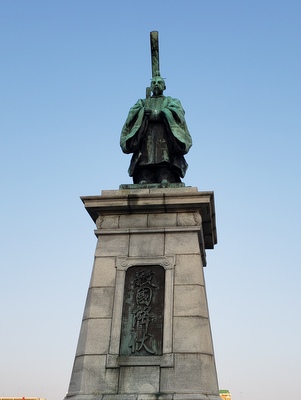Difference between revisions of "Emperor Kameyama"
(Created page with "right|thumb|400px|The gates to the mausolea of [[Emperor Go-Saga|Emperors Go-Saga and Kameyama at Tenryû-ji in Arashiyama, Kyoto]]...") |
|||
| (2 intermediate revisions by the same user not shown) | |||
| Line 1: | Line 1: | ||
| + | [[File:Emp-kameyama-statue.jpg|right|thumb|400px|A statue of Emperor Kameyama erected in Higashi Park in [[Hakata]] in [[1904]], commemorating the emperor's prayers for victory and peace against the [[Mongol Invasions|Mongol invasion]] of [[1274]]. A plaque on the statue reads 敵国降伏, referring to an idea of defeating an enemy not by force but by superior virtue.]] | ||
[[File:Go-saga-kameyama.jpg|right|thumb|400px|The gates to the mausolea of [[Emperor Go-Saga|Emperors Go-Saga]] and Kameyama at [[Tenryu-ji|Tenryû-ji]] in Arashiyama, Kyoto]] | [[File:Go-saga-kameyama.jpg|right|thumb|400px|The gates to the mausolea of [[Emperor Go-Saga|Emperors Go-Saga]] and Kameyama at [[Tenryu-ji|Tenryû-ji]] in Arashiyama, Kyoto]] | ||
*''Reign: [[1259]]-[[1274]]'' | *''Reign: [[1259]]-[[1274]]'' | ||
| Line 9: | Line 10: | ||
His villa in the Arashiyama area of Kyoto was transformed in the 14th century into the Buddhist temple [[Tenryu-ji|Tenryû-ji]]. He is buried there alongside [[Emperor Go-Saga]] (r. [[1242]]-[[1246]]). | His villa in the Arashiyama area of Kyoto was transformed in the 14th century into the Buddhist temple [[Tenryu-ji|Tenryû-ji]]. He is buried there alongside [[Emperor Go-Saga]] (r. [[1242]]-[[1246]]). | ||
| − | + | Kameyama was the common ancestor of the [[Daikakuji and Jimyoin lines|Daikakuji line]] of imperial succession, which alternated for a time with the Jimyôin line descended from his elder brother [[Emperor Go-Fukakusa]]. The division later developed into the Northern and Southern Courts of the [[Nanbokucho Period|Nanbokuchô Period]], which competed in claims to the throne. | |
Latest revision as of 03:54, 1 April 2025

A statue of Emperor Kameyama erected in Higashi Park in Hakata in 1904, commemorating the emperor's prayers for victory and peace against the Mongol invasion of 1274. A plaque on the statue reads 敵国降伏, referring to an idea of defeating an enemy not by force but by superior virtue.
Emperor Kameyama was an emperor of the Kamakura period, reigning from 1259 to 1274.
As Retired Emperor, in 1291, Kameyama established the Buddhist temple Nanzen-ji on the grounds of one of his Kyoto villas.
His villa in the Arashiyama area of Kyoto was transformed in the 14th century into the Buddhist temple Tenryû-ji. He is buried there alongside Emperor Go-Saga (r. 1242-1246).
Kameyama was the common ancestor of the Daikakuji line of imperial succession, which alternated for a time with the Jimyôin line descended from his elder brother Emperor Go-Fukakusa. The division later developed into the Northern and Southern Courts of the Nanbokuchô Period, which competed in claims to the throne.
| Preceded by Emperor Go-Fukakusa |
Emperor of Japan 1259-1274 |
Succeeded by Emperor Go-Uda |
